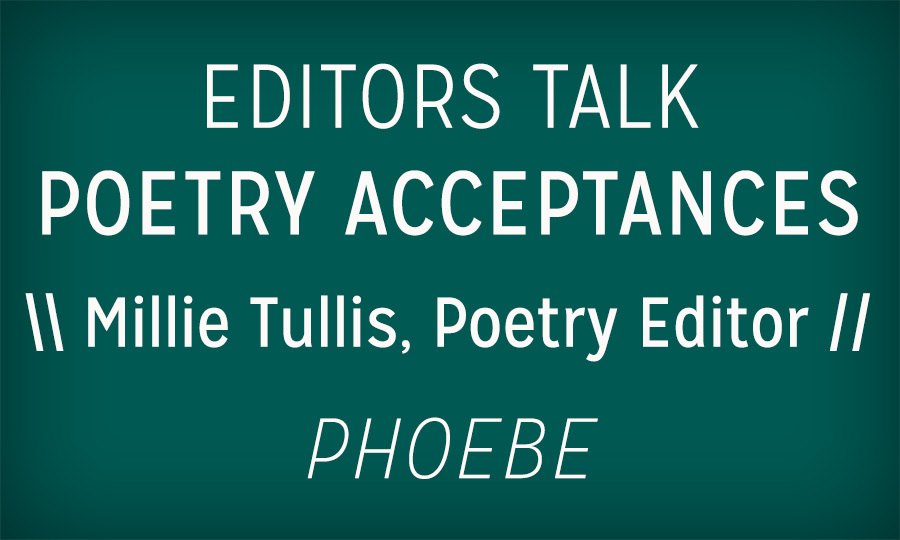Editors Talk Poetry Acceptances: Millie Tullis, Poetry Editor of phoebe

As a platform for emerging poets, our mission is to provide practical help for serious writers. The community lifts itself up together or not at all. In that light, we’ve been asking some great editors from around the literary community for their frank thoughts on why poems may get accepted/rejected from their own slush pile of submissions, and what poets can do to better their chances. Today, we’re speaking with the Millie Tullis, Poetry Editor of phoebe.
From a craft standpoint, what causes you to accept a poem?
Millie Tullis: I can’t say what causes me to accept a poem, because every poem is operating in its own particular way and the decision to accept is a group effort. However, I can talk about what I am often drawn to in a poem and our own process for selecting poetry for publication at phoebe. I find that what causes me to pause or linger when reading submissions is often surprise. I love being surprised by a poem, whether that is through its imagery, line-work, sentence-work, or mode of thinking. I’m always looking, and hoping, to be surprised as I read.
I can also say that at phoebe, our poetry editor (me, currently) reads every submissions in full. The assistant editor (Christian Stanzione) reads at least half of the submissions in full, and we have a team of readers who also do quite a lot of reading. We have monthly meetings and discuss interesting poems in some detail, as well as a final reader meeting, where we make the difficult decisions about what poems we will be accepting. Every poem that gets accepted is talked about a good amount. Poems that get more interesting the more you read them, poems that keep opening up, are often the poems we decide to take.
What advice do you have for new poets who are submitting work?
Submitting is really hard. You have to find the balance between trusting your own work and not assuming that it will get into the first twenty places you send it. From the editorial perspective, I can promise I like a lot of interesting poems that we end up not taking. Work can be rejected for many reasons, and many of these reasons have nothing to do with whether or not the work is “good.”
So my first piece of advice is trust your instinct and try many places before deciding a piece maybe wasn’t as finished as you thought. I also highly recommend reading some recent work from the publication. There are hundreds of journals with different tastes and interests, and you may simply be sending your poem to the wrong journals.
How many rejections have you faced and how do you deal with them?
I think this is a very good question, and I appreciate the invitation to go back and look at my rejections. On Submittable, I have about 300 rejections, but there are a lot of rejections I’ve gotten through other modes of submitting, so maybe the number is closer to 400 individual rejections. And, as most of those rejections are not for one poem, but actually 3-5 poems, I’ve probably had closer to 1000 rejections (though this number sounds pretty preposterous when I say it out loud).
So as a general rule, I try to send a poem or a piece to 25 places before I let myself start to feel bad about it. I also try to always have a few things out, because I find that if I stop submitting, it’s more difficult to start up again. I prefer a steady stream of rejection, I suppose, so that I’m always used to it.
What book of poetry/craft would you always recommend to new poets?
One of the most helpful craft books I’ve read was The Art of the Poetic Line by James Longebach. I also find myself returning to Ariel by Plath over and over again for mentorship.
Millie Tullis serves as the Poetry Editor and Social Media Manager for phoebe and the Assistant Editor for Best of the Net. Her work has been published or is forthcoming in Cimarron Review, Sugar House Review, Rock & Sling, Ninth Letter, Juked, Gingerbread House Literary Magazine, Mud Season Review, and elsewhere.